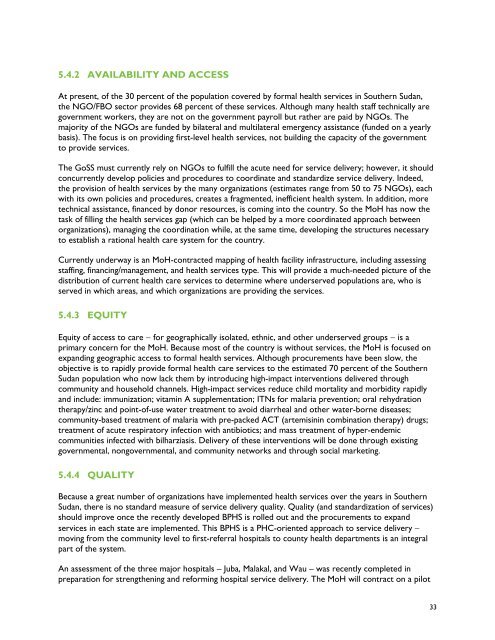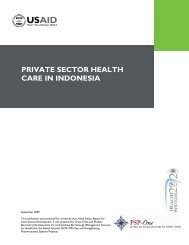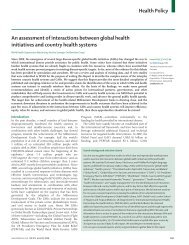southern sudan health system assessment - Health Systems 20/20
southern sudan health system assessment - Health Systems 20/20
southern sudan health system assessment - Health Systems 20/20
Create successful ePaper yourself
Turn your PDF publications into a flip-book with our unique Google optimized e-Paper software.
5.4.2 AVAILABILITY AND ACCESS<br />
At present, of the 30 percent of the population covered by formal <strong>health</strong> services in Southern Sudan,<br />
the NGO/FBO sector provides 68 percent of these services. Although many <strong>health</strong> staff technically are<br />
government workers, they are not on the government payroll but rather are paid by NGOs. The<br />
majority of the NGOs are funded by bilateral and multilateral emergency assistance (funded on a yearly<br />
basis). The focus is on providing first-level <strong>health</strong> services, not building the capacity of the government<br />
to provide services.<br />
The GoSS must currently rely on NGOs to fulfill the acute need for service delivery; however, it should<br />
concurrently develop policies and procedures to coordinate and standardize service delivery. Indeed,<br />
the provision of <strong>health</strong> services by the many organizations (estimates range from 50 to 75 NGOs), each<br />
with its own policies and procedures, creates a fragmented, inefficient <strong>health</strong> <strong>system</strong>. In addition, more<br />
technical assistance, financed by donor resources, is coming into the country. So the MoH has now the<br />
task of filling the <strong>health</strong> services gap (which can be helped by a more coordinated approach between<br />
organizations), managing the coordination while, at the same time, developing the structures necessary<br />
to establish a rational <strong>health</strong> care <strong>system</strong> for the country.<br />
Currently underway is an MoH-contracted mapping of <strong>health</strong> facility infrastructure, including assessing<br />
staffing, financing/management, and <strong>health</strong> services type. This will provide a much-needed picture of the<br />
distribution of current <strong>health</strong> care services to determine where underserved populations are, who is<br />
served in which areas, and which organizations are providing the services.<br />
5.4.3 EQUITY<br />
Equity of access to care − for geographically isolated, ethnic, and other underserved groups − is a<br />
primary concern for the MoH. Because most of the country is without services, the MoH is focused on<br />
expanding geographic access to formal <strong>health</strong> services. Although procurements have been slow, the<br />
objective is to rapidly provide formal <strong>health</strong> care services to the estimated 70 percent of the Southern<br />
Sudan population who now lack them by introducing high-impact interventions delivered through<br />
community and household channels. High-impact services reduce child mortality and morbidity rapidly<br />
and include: immunization; vitamin A supplementation; ITNs for malaria prevention; oral rehydration<br />
therapy/zinc and point-of-use water treatment to avoid diarrheal and other water-borne diseases;<br />
community-based treatment of malaria with pre-packed ACT (artemisinin combination therapy) drugs;<br />
treatment of acute respiratory infection with antibiotics; and mass treatment of hyper-endemic<br />
communities infected with bilharziasis. Delivery of these interventions will be done through existing<br />
governmental, nongovernmental, and community networks and through social marketing.<br />
5.4.4 QUALITY<br />
Because a great number of organizations have implemented <strong>health</strong> services over the years in Southern<br />
Sudan, there is no standard measure of service delivery quality. Quality (and standardization of services)<br />
should improve once the recently developed BPHS is rolled out and the procurements to expand<br />
services in each state are implemented. This BPHS is a PHC-oriented approach to service delivery −<br />
moving from the community level to first-referral hospitals to county <strong>health</strong> departments is an integral<br />
part of the <strong>system</strong>.<br />
An <strong>assessment</strong> of the three major hospitals – Juba, Malakal, and Wau – was recently completed in<br />
preparation for strengthening and reforming hospital service delivery. The MoH will contract on a pilot<br />
33
















